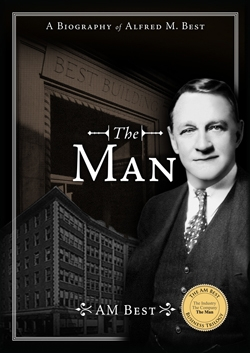The Man
The Man is a robust biography that pays tribute to Alfred M. Best, the founder of a credit rating business.
Put together by the company he founded, Alfred M. Best’s biography The Man reveals him in the context of his family and other relationships.
Beginning with the founder’s origins, the book reveals that Best’s father’s business success fluctuated such that, in 1892, fifteen-year-old Best went to work in New York City instead of continuing his education. He kept learning at his jobs, though, and worked his way up in insurance companies. He eventually started his own credit rating agency.
In addition to his work, the book covers how Best sang in choral societies, and how he and his first wife, Constance, had three children and spent summers in Vermont. It reveals that, after Best bought a building for his growing business, his debts mounted. He had an affair and divorced Constance. Following the deaths of his son and second wife, he retired. He died in Vermont in 1958, having reunited with Constance.
The book is part of a trilogy put out by the AM Best company. This volume’s fourteen chapters each focus on a topic specific to Best’s life: his singing, children, farm, and projects are covered. Each chapter concludes with a summary assessment of Best in its area, resulting in a dry, objective tone.
Best’s character is addressed through the prism of his own principles of experience, fairness, and innovation. Vignettes about business dealings and friendships mirror his business rating system, suggesting that he worked to live up to his own standards. The rating system was the first of its kind and became popular, and the book acknowledges this success. But it also suggests that Best struggled to be fair: he is depicted lending money to those who do not pay him back, in some cases leading to his own debts.
Newspaper clippings and anecdotes further enliven the scandals of Best’s life, including those he was involved in during Prohibition, during when he encountered shady individuals. The question of how his second wife actually died results in some intrigue. Nonetheless, some of the book’s sections are too bogged down in their archival details to hold interest.
Paintings by Best’s son, Dexter, are among the most striking images in the book. They couple with photographs of the Vermont countryside to convey Best’s ideals of solidity and natural tranquility, which the text said he did not always achieve. Other artifacts, including pieces of correspondence, speak to Best’s busy and well-connected nature; some are included in their entirety, suggesting the book’s value as a work of historical preservation, even beyond Best’s story.
The Man is a robust biography that pays tribute to Alfred M. Best, the founder of the credit rating business that commissioned it.
Reviewed by
Mari Carlson
Disclosure: This article is not an endorsement, but a review. The publisher of this book provided free copies of the book and paid a small fee to have their book reviewed by a professional reviewer. Foreword Reviews and Clarion Reviews make no guarantee that the publisher will receive a positive review. Foreword Magazine, Inc. is disclosing this in accordance with the Federal Trade Commission’s 16 CFR, Part 255.

